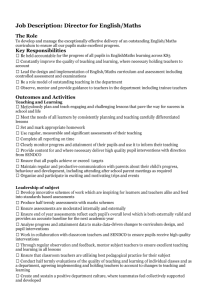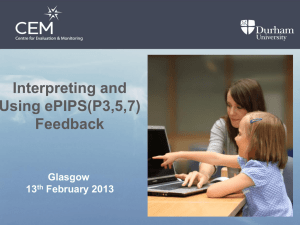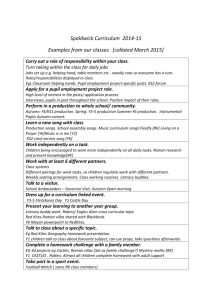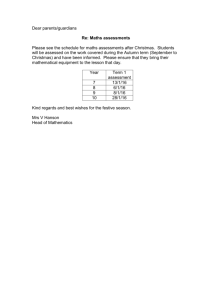Reporting and Assessment Policy
advertisement
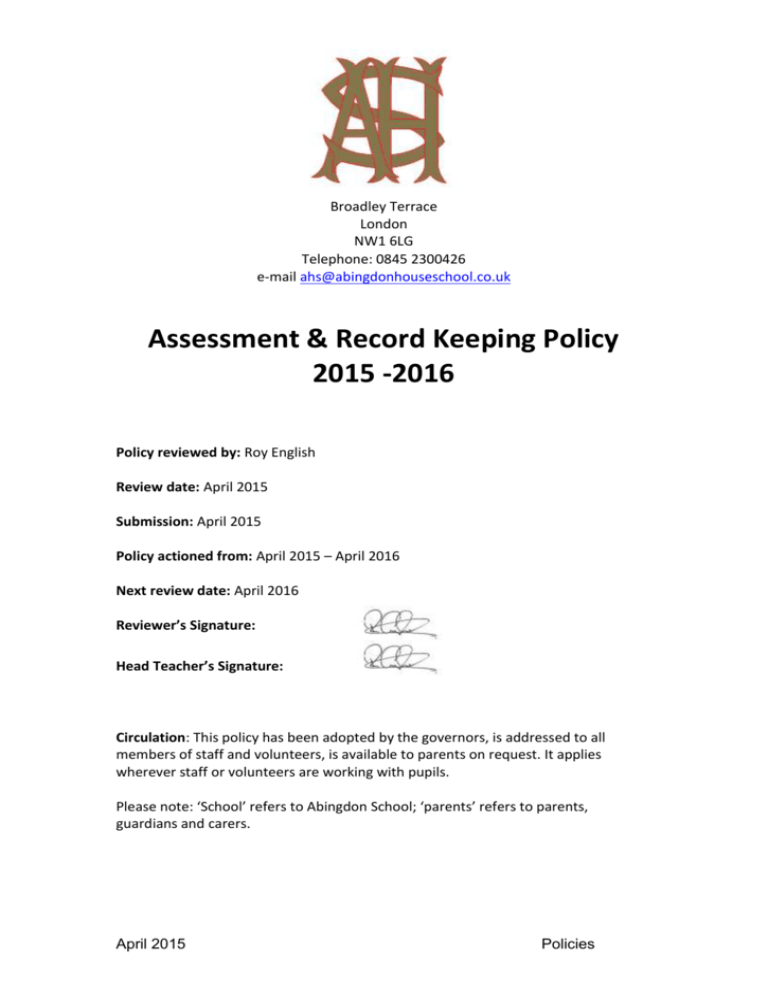
Broadley Terrace London NW1 6LG Telephone: 0845 2300426 e-mail ahs@abingdonhouseschool.co.uk Assessment & Record Keeping Policy 2015 -2016 Policy reviewed by: Roy English Review date: April 2015 Submission: April 2015 Policy actioned from: April 2015 – April 2016 Next review date: April 2016 Reviewer’s Signature: Head Teacher’s Signature: Circulation: This policy has been adopted by the governors, is addressed to all members of staff and volunteers, is available to parents on request. It applies wherever staff or volunteers are working with pupils. Please note: ‘School’ refers to Abingdon School; ‘parents’ refers to parents, guardians and carers. April 2015 Policies 1. Initial Assessment Pupils can enter AHS at any age between Year 1 and Year 9. Initial assessment is designed to assess suitability for entry to the school, as well as strengths and weaknesses, barriers to learning and learning style. 1.1 Previous reports Upon receipt of an enrolment request, the parents are asked to provide copies of all relevant reports e.g. Educational Psychologist’s Report, School reports, Therapy reports, etc. The previous school, LA and/or other agencies may also provide information. 1.2 Parent Visit If it appears that the school would be suitable to meet the child’s needs, the parents are then invited to visit the school for a tour and a meeting with the Head. Before the meeting they are asked to complete a parental questionnaire. They have the opportunity to give their view of the child's strengths and weaknesses. If the parents wish to proceed with the enrolment application, the child is invited to attend the school for a two-day observational assessment. 1.3 Observation Days Assessment is multi-disciplinary by a team consisting of Head, Teachers, Educational Psychologist, Occupational Therapist, Physiotherapist and Speech and Language Therapist and SENCO as appropriate. Some of these may be done by external sources. 1.4 Educational Psychologist’s Assessment WISC lV or WIPSI gives a full scale, verbal and performance IQ. Sub test scores show patterns of strength and weakness. 1.5 Speech and Language Assessment Strengths, weaknesses, need for therapy for receptive, expressive language and for phonological awareness. 1.6 Occupational Therapy Assessment Strengths, weaknesses, need for therapy for visual perception, visual memory, motor skills and planning. 1.7 Physiotherapy Assessment Strengths, weaknesses, motor skills and planning. A key part of the assessment is informal observation. This includes an informal session with the SENCO. Most pupils are observed in class situations. This is completed over two days with key staff being involved in a case conference during the first day to give time for further information to be obtained prior to the place being offered. 1.8 Parental Interview At the end of the second day, the parents are invited to meet with the Head and the SENCO . Information on testing and observations is given to parents, whose views are also sought by the assessment team. Parents are helpful in April 2015 Policies determining whether what was observed is typical or atypical of the child's normal performance. If it is deemed that the school can meet the child’s needs, the Head will make an offer of enrolment. On rare occasions, further observation days or assessment information may be requested. 2. Assessment once pupils at Abingdon House School 2.1 Introduction At Abingdon House School we carry out a variety of assessments throughout the academic year to assess current levels of working and identify areas for development. In literacy and maths we use a combination of continuous assessment and diagnostic tests to ascertain which national curriculum levels the children are currently working within. Each academic year in mainstream school, children are expected to make 2 sub-level jumps of progress e.g. level 3C > 3A is appropriate progress. The following grid show age related expectations for national curriculum levels. Level End End of End of End End End End End End of Yr1 Yr 2 Yr 3 of Yr of of Yr of Yr of of Yr 4 Yr5 6 7 Yr8 9 1C 1B 1A 2C 2B 2A 3C 3B 3A 4C 4B 4A 5C 5B 5A 6C 6B 6A 7C 7B 7A Working below age related expectations Working at age related expectations Working above age related expectations Exceptional working levels April 2015 Policies 2.2 Diagnostic Testing In addition to our national curriculum assessments, we use diagnostic tests biannually to assess progress in: Reading , Spelling, Mental maths age, Literacy ages (for the lower school only) 2.3 Diagnostic Tests Standardised assessments are subjective and therefore these test results are used as a tool alongside teacher assessments. The assessment levels seen in reports are a combination of diagnostic test results and continuous teacher assessments. The testing we use is dependent on the national curriculum levels of the children we are working with. All of our assessments are specifically chosen for their accessibility to children identified as having special educational needs. Across the school we use: Neale Diagnostic Reading Test Helen Arkell Spelling Test 2 Hodder Basic Number Screening Test for Upper School Maths Hodder Numeracy Progress Tests for Lower School maths Hodder Early Literacy Test for Lower School literacy only (*often in place of Neale) 2.4 Continuous Assessment – Assessing Pupil Progress (APP) Our continuous assessment is carried out through the use of APP assessment grids. These grids outline the skills the children need to demonstrate independently in reading, writing and maths to attain each national curriculum level. These grids are working documents which are added to throughout the year as the skills develop. 2.5 Important Information It is important to point out that there will often be a disparity between mental maths ability age and national curriculum levels, as the national curriculum assessments require correct and consistent use of a variety of strategies which are not required in the ‘Mental Maths Age’ assessments. In addition it is important to point out that in reading assessments, if there is huge progress in one area of reading (such as comprehension) you may see a slight relapse in other areas of reading such as reading rate, as children who are reading with higher levels of comprehension, often slow their reading pace. The national curriculum expectations only give a broad indication of what the majority of children nationally are expected to achieve. Children’s progress may not always be in line with age related expectations. They may make a huge leap one year and spend a year consolidating before forging ahead again the next year. It is also important for teachers, parents and pupils to focus on what the individual child is achieving. Consider how much progress April 2015 Policies they have made in the last year, rather than only considering age related expectations. 2.6 Educational Psychologist’s Reassessment Pupils are reassessed if: Progress or behaviour is giving cause for concern at a level where psychological input would be useful. Pupils are reassessed if it is apparent the needs were not fully identified by initial assessment. 3. Transitions 3.1 Pupil Review including Moving to the Next Year Group At the start of each term a class-based conference will be held with the class teacher, SENCO, special provision staff and therapists to discuss the previous term’s IEP cycle and make recommendations for the term. Teachers also use information from a pupil's individual office file and/or their class-based pupil profile to complement any relevant information passed from the previous teacher. During INSET the Head will bring to the attention of all staff any relevant matters concerning individual pupils. 3.2 When pupils are moving on to a new school A Leaver's Pack containing work samples, the current IEP and the most recent school report are forwarded. The school report provides the most recent results of standardised testing and National Curriculum attainment levels are also contained in the final report. 4. Record Keeping 4.1 Individual Education Plans (IEPs) are developed for each pupil and reviewed every term. The IEP keeps a record of current priority learning targets, and current and past assessments, and significant notes. 4.2 Pupil Progress Reports are sent home in February and July. They record the latest National Curriculum levels, results of standardised and diagnostic testing, and a descriptive narrative about their achievement. 4.3 Pupils Progress Reports are followed by Parent/Teacher meetings. 4.4 All IEPs and Reports are kept on file both electronically and in hard copy in individual pupil files. 4.5 All results of standardised and diagnostic testing are passed on to the School Office where they are recorded on the SIMS database. 4.6 In June each year, the Director of Studies produces a report summarizing pupil attainment for the Alpha Plus Directors and Governors. 4.6 In July each year, the Head sends a report to parents on pupil achievement which makes a comparison with national results/agereferenced norms. April 2015 Policies
